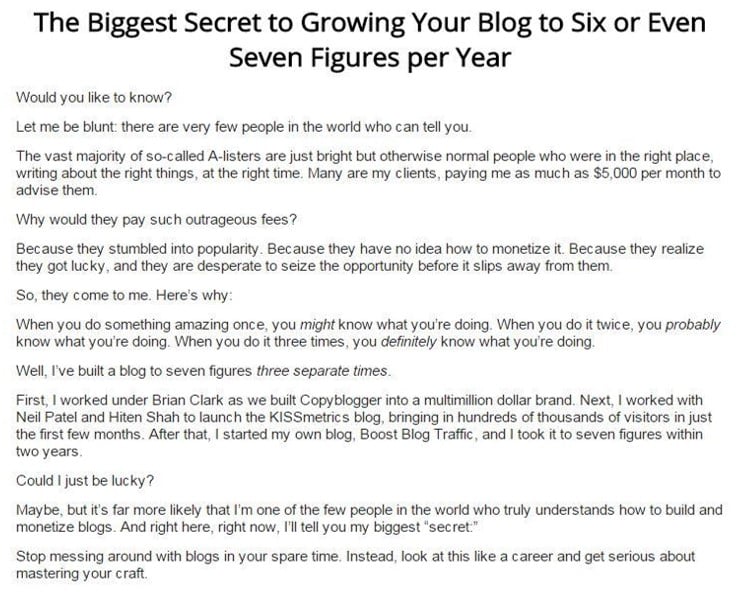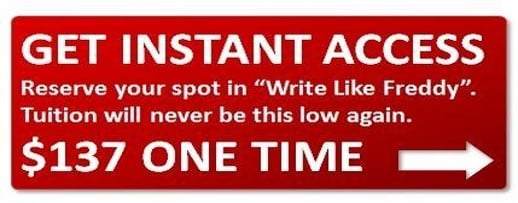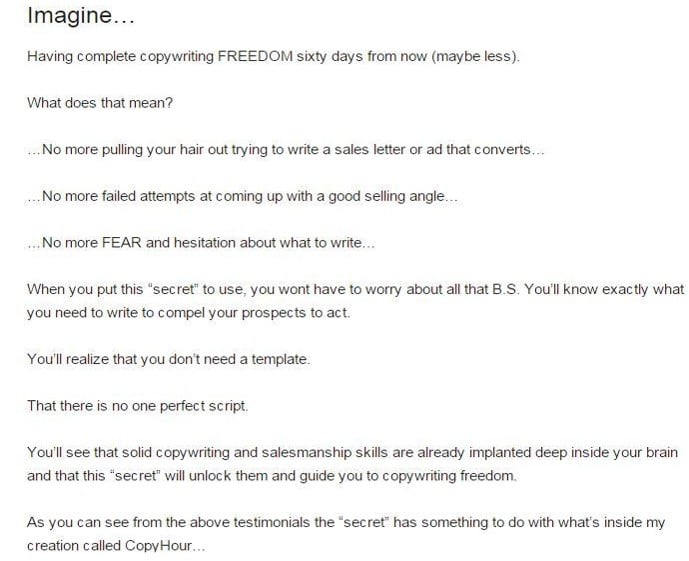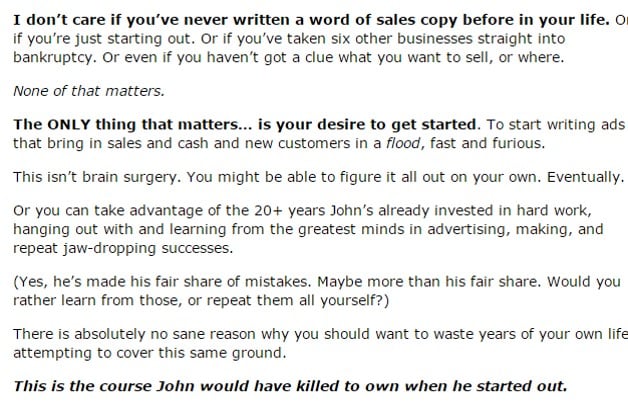5 Brain Hacking Copywriting Secrets to Soar Conversions and Sales
Hassan Ud-deen
If you’re reading this post, chances are that you’re selling something: a coaching package, a service of some kind, or a product.
You know that your sales and conversions could be better.
But every time you go looking for a solution, your heart slips slowly back down your throat as you encounter the same advice: Replace verbs with adjectives. Use short sentences. Cram your copy with power words.
Don’t get me wrong: this is sound advice that works.
But what if I told you there are 5 lesser known copywriting techniques you can add to your marketing repertoire to:
- Explode your readers’ desire in what you’re selling.
- Make your readers want to comply with your amazing offer.
- Position yourself so premium prices seem like irresistible offers.
- Keep readers glued to your copy.
- Skyrocket your chances of getting a positive response.
These hypnotic techniques are being used on you every day, and you probably haven’t noticed.
Don’t believe me?
Keep reading and I’ll show you not only how they’ve been used on you, but how you can start using them to make your conversions and sales soar.
Brain Hack #1: The Magical Power of Open Loops
Ever had a favorite TV show that you couldn’t stop watching?
Or maybe a series of books that you were addicted to?
What about a compelling headline that made you dive into a post?
Why am I asking all these questions? You’ll find out soon. But before that, let’s talk about open loops.
Open loops take advantage of our brain’s natural craving for completion. You see, our brain enters a state of confusion when it views something as incomplete. The cause could be a story, a movie, even a household chore you’re trying to finish. But tension won’t be relieved until you feel that you’ve completed the task at hand.
When it comes to writing your sales page, an open loop would be a part of your story or sales letter that doesn’t immediately tie up the story.
A great example of this technique in action is how I gave three questions at the beginning of this point and didn’t tell you why.
Or how the title of this post “5 Brain Hacking Copywriting Secrets to Soar Conversions and Sales” nudges your brain into thinking about what those tips are, and how exactly do they hack your brain?
You can apply open loops to any kind of writing where you want people to take an action (ie become a conversion). Here’s how you’d apply the open loop hack to email opt in copy.
Typical Opt In Copy
Join 5,500 other marketers and learn:
- How to increase your profits with email
- Growth Hacks for your business
- How to make customers repeatedly buy from you
Opt In Copy Using the Open Loop Brain Hack
Sign up for your free email hacking guide. You’ll learn:
- 5 email marketing secrets that tripled my revenue.
- The little-known secret used by Hollywood to keep people addicted to movies – and how you can do the same with your business.
- The 18 point checklist to help you quickly create an email course that your subscribers will devour.
Sales Page Copy Using the Open Loop Brain Hack
Another masterfully executed example of open loops in copy is from a sales page that recently “hypnotized” me into buying. (Yes, I too am a mere mortal.)
 I didn’t even read the whole page before my desires slapped me in the face, and there I was squinting at the screen, eagerly punching my credit card details in.
I didn’t even read the whole page before my desires slapped me in the face, and there I was squinting at the screen, eagerly punching my credit card details in.
Jon Morrow’s Serious Bloggers Only sales page had me sold.
He starts by opening a giant, itching loop in your brain by mentioning “the biggest secret”. This instantly makes you want to find out what this “big secret is” and drives you to read on.
He then does something really clever.
After creating an itching open loop in your mind, he then creates even smaller open loops that fuel your curiosity to find answers. These smaller loops seductively caress the edges of your burning desire, and slowly tease you down the page.
Brain Hack #2: Linguistic Binds to Scramble Readers’ Brains
A linguistic bind happens when the writer gives the illusion of choice by changing his wording, when really, all the options have the same outcome.
Binds cause a state of slight confusion, and then capitalize on that state.
How? Well, it might be surprising to you.
Confusion isn’t a very sought after state by most people. This means our brains are inclined to escape from this state as fast as possible, usually by accepting the first logical way out of that confusion.
When the word “or” is used in a bind, people expect the next choice to oppose the first. And when it doesn’t, the brains enters a state of micro-confusion.
After this, the person using the bind will ramble on a little to camouflage the bind, and finish with a question to nail down a response.
Here’s an example.
Would you like to go ahead and make an appointment now, or should we just jot down a time when we can meet? Either way, it’s important that we discuss the matter further. Don’t you think?
When you read the first example, it looks like multiple options are given. But a closer look reveals that the reader is given the option to “make an appointment now” or “jot down a time” to meet. Same option, just worded differently
How to make your own linguistic binds:
- Decide what you want the reader to respond to. This is the action you want from the reader.
- Give two “options” that are the same, but worded differently.
- Keep talking to camouflage the bind.
- Ask a question to pin down a response.
Here’s another example, this time from GetManiac’s (SEO firm) contact form.

See what’s going on here?
It looks like they’ve given you three options, but all those options lead to one outcome: you contacting them. This leads to a huge increase in conversions and sales, so give it a try the next time you’re writing a sales page or opt in page for your website!
Brain Hack #3: Embedded Commands that Hypnotize Readers
The ultimate purpose of your copy is to get the reader to act. Right?
Whether you want someone to subscribe to your newsletter, sign up for your mailing list or call to make an appointment, there’s a specific action you want the reader to take.
Embedded commands make it easier to get that action. (I’ve already used one on you.)
They tiptoe past the scrutiny of the logical side of the brain and create a subconscious desire for the reader to act on what you say, without them knowing where the desire came from.
Take a look at this sentence:
“I wonder how quickly you will read every single word of this post”.
Looks innocent enough right? Well, look again.
Like a sniper hiding in the undergrowth, the hypnotic command isn’t obvious, but it’s definitely there.
In this example, it’s “you will read every single word of this post”.
See how it gives your brain a small psychological nudge?
Embedded commands are a simple weapon to use.
First, construct your command. This is basically the action you want the reader to take.
Some examples are:
- Comment below
- Pick up your copy now
- Read every single word
Then simply embed the command into a sentence.
If the action you want is for the reader to “read every single word,” your sentence would go:
Want to learn about hypnotic devices that will make customers drool for your products? If so, read every single word of this article to find out how.
Another interesting example is Danny’s Write Like Freddy course sales page.
Take a look at the purchase button below.

The embedded commands being get instant access and reserve your spot.
Brain Hack #4: Presuppositions to Slip Inside Your Readers’ Brains
Presuppositions about a person, situation, or object bombard the brain with multiple thoughts. This forces your brain to accept certain statements as facts, so that it can complete a thought.
This is what makes presuppositions such a powerful weapon in your copywriting arsenal.
Look at this question.
What will you do with the extra $4,500 you’ll be earning every month?
When someone reads this, their brain is fixed on the first part (what will you do). And in order to make sense of and answer the question, the brain momentarily assumes that the second part (you’ll be earning $4,500 every month) as a solid fact, just to complete the question.
This is incredibly powerful, because it leads your readers to involuntarily imagine how their lives will be difference once they’ve worked with you. This is the ultimate goal for every business owner, because once your readers can envision where they will be after they’ve enrolled in your course, signed up for your email list, or started coaching with you, they are much more likely to take that action and make their dreams a reality.
One awesome example of this technique is the copy hour (copywriting course) sales letter.

Now, this example is slightly different from the first one that I gave.
This example doesn’t lead with a question, but still uses multiple thoughts to distract the reader and force him to picture himself benefiting from the product.
It starts by telling you to imagine, to which the brain responds with “imagine what?”
But by then, it’s too late. You’ve already pictured yourself as a hotshot copywriter and your desire for the product increases tenfold.
Brain Hack #5: Re-framing to Skyrocket Your Value
Re-framing is when you increase the value or appeal of a product by making comparisons to shift the focus of your reader.
Successful re-framing lies in changing the “buying lens” from which readers view your product to make the buying decision much easier.
Here’s an example of re-framing in action:
What price can you place on learning how to get more copywriting clients than you can handle? $5,000? $3000? $2000? (You can easily earn that within a month of learning how to secure clients.)
My standard fee for private coaching starts at $300/hour and in my supercharged copywriting course you get over 15 hours of my teaching. That would cost you $4,500.
The supercharged copy course won’t cost you anywhere near that. This fantastic investment in your career and life is only…
$260.
You’ll most likely earn twice that much with your first gig.
In this example, there are actually two re-framings going on at the same time. The first occurs when the price of the copywriting course ($260) is compared to how much you can earn in your first month ($2000). The second happens when the price of private coaching ($4500) is compared to the price of the course ($260).
This takes the reader by the hand and shifts their view of the product from being a boring “$260 video course” to a “wise investment” in which they are saving $4460.
Here’s another example from John Carlton’s kick ass copywriting secrets course.

It took John 20+ years of painfully piecing copy together and learning from the greats to become a legendary copywriter.
And he presents his course as a shortcut to the ocean of knowledge that he had to fight tooth and nail for. Taking his course is also a way to shave years of your marketing education, instead of stumbling around on your own.
Beats the sleazy “buy now” endings typical on most sales pages, doesn’t it?
Your Next Steps Towards Copy that Whips Readers Into a Buying Frenzy
Now that you know about these brain hacks and how they’re used, it’s time for the fun to begin.
The first step to implementing these hacks to improve your copywriting, conversions, and sales is to pay attention to when they’re used. If you find yourself magnetized to a piece of writing, stop. Go back. Look at what “got” you. How and why did it hold your precious attention?
Once you understand how you were “got,” work on including the technique in your own writing.
Then get a small group of people to read your copy with the technique used and your copy without the technique in it, asking which version grabbed their attention more or compelled them to action?
That’s all there is to it. All you have to do now is take action.
P.S. How many times did I use the tips I talked about in this blog post? Tell me in the comments below. (Embedded command much? :-))
Belinda Weaver
Great post Hassan and I followed your commands right to the very last word 😉 I particularly the examples you included.
I use embedded commands quite a lot but I agree with Kitty, too many open loops frustrate me as a reader. It feels cheesy and deceptive (IMHO). But the right balance of open loops and detail can be very compelling.
I think I’ve revisit my sales pages with this post open!
Hassan Ud-deen
Hey Belinda,
Haha embedded commands can be effective can’t they.
Yeah I kinda hate too much open loops too. But god, do they fascinate me. I always find myself boiling with curiosity when I don’t have the complete answer to something. And even though I know it’s an open loop, i’ll still fall for it!
Thanks for reading!
mohammad umair
This is an epic post Hassan. One of the best I have ever read. This post is in the class of Neil Patel (no I’mm not joking). The reason? This post effectively conveys the message in a simple manner (& language) much like the thought leaders of digital space.
Thanks for this post.
Danii Turnbull
Fantastic article Hassan. So many useful and helpful points in here, have printed and made notes everywhere! Thank you
Jennie
Hi Hassan,
Great post. Seriously. I’m always looking to learn more and improve my copy and this list has been a great read. Like others i’ve bookmarked it and will be coming back each and every time I craft a new post 🙂
Thanks again!
Jennie
Gary Greenfield
How much have I benefitted by the content of this post? By taking the 8 minutes to read it, I saved at least $40 (given the hourly fee you mentioned in Hack #5) because I got this outstanding information for free! I will earn 100 times that amount from the first sales letter I write using the Re-framing technique along with the other 4.
What do you think, Hassan? Is the above comment a reasonable example of re-framing?
Hassan Ud-deen
Haha learning very quickly Gary.
Excellent implementation!
Krithika Rangarajan
Hey Hussain
I ‘kept reading’, but you ended this article too soon! 😉 I could read your words forever without any ’embedded’ commands!
Bravo – love this post
Thank you #HUGS
Kitto
Krithika Rangarajan
Ha – so engrossing were your words that I misspelled your name!
My apologies, Hassan 🙁
Hassan Ud-deen
Haha thanks Kitto
#Hugsback
What was your favorite point?
Hope it’s useful to you 😉
Krithika Rangarajan
Open loops bug the heck outta me 😉
However, I do believe we need to use this tactic wisely (and sparingly), lest our readers think it’s ‘click-baity’, right?
But they do work their magic on me! LOL
I also enjoy embedded commands’ because they are covert without being sneaky, and subtle without being vague! 😀
Thanks again, Hassan
Kitto
PS: I love doling out hugs, so here is another one for ya #HUGS 😉 (You deserve a thousand warm hugs for this brilliant post)
Pamela
It’s interesting and educational to see copywriting strategies un-cloaked in this way. What I find isn’t vibing with me is the military language and metaphor: “command,” “sniper,” “distract,” “bombard,” “arsenal.” I’m not trying to ambush or force my reader–who is also my prospective client–I am hoping to magnetize, to lay the foundations for a positive working relationship. Perhaps I am not your ideal client for this post, but I am wondering if there is a way to talk about strategy that doesn’t come down to manipulation? That would be even more fascinating to me.
Hassan Ud-deen
Hi Pamela,
I totally understand where you’re coming from and I agree. When it comes to writing copy you always want to seduce and entice your reader, not force him into buying what you’re selling. The tips above are just small psychological devices that boost the seductive power of what you’re selling.
Thanks for reading Pam
Donna
Excellent! I’ve read many articles on sales copy writing; and yours is among the BEST! I will incorporate these into my content copy once I absorb it.
Hassan Ud-deen
Thanks Donna!
adc7jc@gmx.com
Awesome content Hassan,
Sure got my mind spinning with all the options. Now I see why my head goes crazy when advertizing my book. I’ve been trying to use most of those methods into one 🙂 That’s enough to drive anyone nutz.
Thanks for the great content. Will surely use it.
Alex
Antoniya KZ
Hi, I have read your post but will re-read it again every time I write blog posts for a month to get the hang of the techniques.
I especially like the one with the “or” giving two options that are the same thing. I have used “or” up until now to actually give two different options! Both of them what I want them to do but actually I realize now I can leverage the power of all actions into ONE single thing and accelerate it’s growth.
Thank you!
Hassan Ud-deen
Antoniya yeah I also found linguistic binds fascinating. Interesting little buggerz aren’t they?
Embedding copywriting techniques into your posts can be an excellent way to make them more entertaining and engaging.
Good luck,
Hassan
Rahmat
Excellent! I think this post more valuable than many ebooks I bought. Great job! I’m learning copywriting and this post very helpful.
Thank you.
Hassan Ud-deen
Hey Rahmat,
Yeah the right technique can have some awesome power when it comes to creating copy. For more info on copy check out Garyhalbert and John Carlton, they’re both masters of their craft and you can learn a ton from them.
antonroder@gmail.com
Very nice piece. Gives one great insight into how other people get us to buy their stuff as well.
Mike
I want to improve my craft in copywriting so I really find your post very helpful.
Thanks for a great post Hassan!
Cheers,
Hassan Ud-deen
Thanks Mike,
What was your most favorite point?
Have a great day,
Hassan,
Zarayna
Hi Hassan,
I have only had time to scan your above post but even I can see it is excellent. Thank you!
I shall read properly and digest later, hopefully, but in the meantime, a very useful and insightful guide so am very impressed and grateful.
Kindest regards.
Hassan Ud-deen
Thanks Zarayna,
Hope you find value in the post!